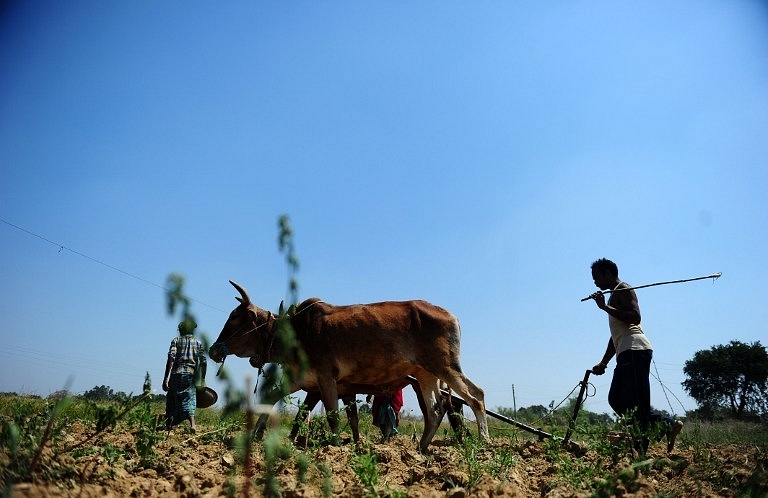Economy
Can Modi Change The Dynamics Of Wealth Creation In Rural India?

The effects of the economic policies of the Modi government on rural India will take time to show up. But once they do, it is likely that they would generate a more equitable demand from the rural areas.
So the monsoon has starting withdrawing from Northwest India on schedule, according to reports, dashing all hopes of some late showers that could mitigate the effects of deficient rainfall this season. This means two years of weak rainfall.
At 1.9 per cent, growth in gross value added (GVA) segment in the agriculture, forestry and fishing sector in the first quarter (Q1) of 2015-16 was almost half of what it was in 2014-15 . The Q1 figures are based on Rabi crop output. The weak monsoon will mean that even the Kharif output will get affected.
What, then, does this mean for rural demand, which is supposed to account for almost half of total demand? This is a crucial question, since the revival of demand is happening very slowly.
Rural demand was anyway under pressure. In February, a report by Ambit Capital, Rural India: At the Crossroads, had noted that “after seven years of frenetic growth, the rural and semi-urban India story now faces serious challenge”.
The report had pointed out that the growth in rural demand had been fueled by massive flow of subsidies during the United Progressive Alliance (UPA) regime. Given the massive leakage of subsidies, the report argues, the subsidy flood really buoyed the income of the top few income groups in rural areas.
But the combined effect of the subdued hike in minimum support prices (MSP) by the Narendra Modi government, poor monsoons (in 2014) and global moderation in food prices, the Ambit report says, weakened rural demand.
There is, however, a silver lining in the form of this government’s approach on subsidy reform and infrastructure focus. This, the report says, could see a change in the dynamics of wealth creation in rural India.
The report argues that the Jan Dhan accounts and gradual move towards direct benefit transfer (DBT) into these accounts will plug subsidy leakages which were benefiting the rural elite. “As leakages in the subsidy mechanism are reduced and as the DBT mechanism becomes more ubiquitous, there is likely to be a redistribution of wealth in favour of the poorest deciles of society (which, ironically, will hit aspirational consumption, and help small ticket consumption).
The report also expects the government’s infrastructure push – roads, low-cost housing – to kick off from the second half of this fiscal. This, it says, could give a boost to the construction sector, generating demand for labour and having a positive effect on rural wage growth. Rural wage growth may not recover to the 15-21 per cent levels seen over 2009-12, it says, “but a mean reversion from the 4 per cent wage growth seen in 2014 seems likely”.
But this structural shift in rural consumer demand is not expected to come overnight. The report expects that these sources of demand will take at least two to three quarters to kick in, “Hence, it appears that the traditional drivers of rural India’s prosperity (generous subsidies which partly were stolen by the rural elite and then were channeled into land, gold and real estate) would be missing for 2-6 quarters without the new drivers kicking in.”
It could, however, take longer. While the Jan Dhan accounts are increasing in number, the transfer of subsidies and other government doles directly into them is not quite picking up. Direct cash payout of food subsidy has only just started as a pilot in Chandigarh. Given that digitisation of beneficiary lists, computerisation of the public distribution systems in states and problems in banking infrastructure is holding up the roll out of the National Food Security Act, the direct benefit transfer (DBT) of food subsidy will also get delayed. DBT cannot start without a proper identification of eligible beneficiaries.
Direct transfer of fertiliser subsidies to farmers is not on the agenda now, given that these are currently in the form of producer subsidies; the fertiliser subsidy regime itself has to be restructured and that will take time.
While public investment in infrastructure does appear to be picking up – the share of capital expenditure in total government expenditure has increased from 12 per cent in April-July 2014 to 14 per cent in April-July 2015 – private investment is still subdued.
A rural India renaissance may just take some more time than expected. But the renaissance, when it comes, will be driven by a restructuring of wealth generation on the lines that the report mentions. That should be something to look forward to.
Support Swarajya's 50 Ground Reports Project & Sponsor A Story
Every general election Swarajya does a 50 ground reports project.
Aimed only at serious readers and those who appreciate the nuances of political undercurrents, the project provides a sense of India's electoral landscape. As you know, these reports are produced after considerable investment of travel, time and effort on the ground.
This time too we've kicked off the project in style and have covered over 30 constituencies already. If you're someone who appreciates such work and have enjoyed our coverage please consider sponsoring a ground report for just Rs 2999 to Rs 19,999 - it goes a long way in helping us produce more quality reportage.
You can also back this project by becoming a subscriber for as little as Rs 999 - so do click on this links and choose a plan that suits you and back us.
Click below to contribute.
Latest